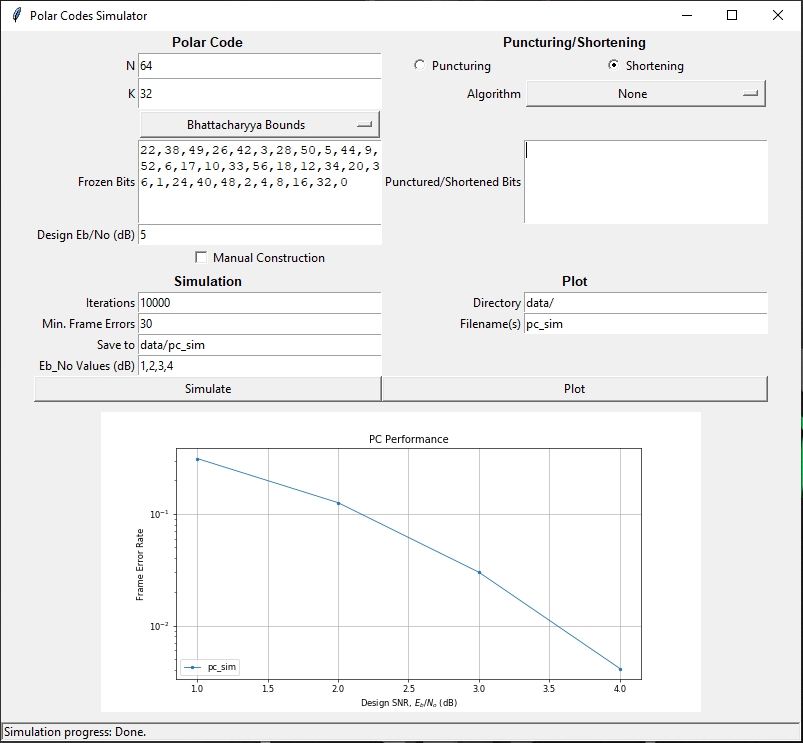A package for polar codes in Python.
Project description
Polar Codes in Python
A library written in Python3 for Polar Codes, a capacity-achieving channel coding technique used in 5G. The library includes functions for construction, encoding, decoding, and simulation of polar codes. In addition, it supports puncturing and shortening.
It provides:
- a systematic and non-systemic encoder.
- non-recursive implementations of the successive cancellation decoder (SCD).
- mothercode construction of polar codes using Bhattacharyya Bounds or Gaussian Approximation
- support for puncturing and shortening.
- Bit-Reversal Shortening (BRS), Wang-Liu Shortening (WLS), and Bioglio-Gabry-Land (BGL) shortening constructions.
- an AWGN channel with BPSK modulation.
- an easy-to-use Graphical User Interface (GUI)
Documentation:
- Main reference (pdf)
- Quick reference (website)
- Introduction to polar codes, shortening, and the library: http://www.youtube.com/watch?v=v47rn77RAxM
Getting Started
- Install the package with
pip install py-polar-codesfrom https://pypi.org/project/py-polar-codes/. - Install matplotlib from https://matplotlib.org/users/installing.html.
- Install numpy from https://docs.scipy.org/doc/numpy/user/install.html.
- Run test.py using a Python3 compiler. If the program runs successfully, the library is ready to use. Make sure the compiler has writing access to directory "root/data", where simulation data will be saved by default.
- Call
GUI()to start the GUI.
Examples
Mothercode Encoding & Decoding
An example of encoding and decoding over an AWGN channel for a (256,100) non-systematic mothercode, using Bhattacharyya Bounds for construction and SCD for decoding.
For systematic encoding and decoding, replace Encode(myPC) with Encode(myPC, 'systematic_encode') and Decode(myPC) with Decode(myPC, 'systematic_scd').
import numpy as np
from polarcodes import *
# initialise polar code
myPC = PolarCode(256, 100)
myPC.construction_type = 'bb'
# mothercode construction
design_SNR = 5.0
Construct(myPC, design_SNR)
print(myPC, "\n\n")
# set message
my_message = np.random.randint(2, size=myPC.K)
myPC.set_message(my_message)
print("The message is:", my_message)
# encode message
Encode(myPC)
print("The coded message is:", myPC.get_codeword())
# transmit the codeword
AWGN(myPC, design_SNR)
print("The log-likelihoods are:", myPC.likelihoods)
# decode the received codeword
Decode(myPC)
print("The decoded message is:", myPC.message_received)
Shortened Code Construction
An example of constructing a shortened polar code with Bit-Reversal Shortening (BRS) algorithm.
The shortening parameters are set by the tuple shorten_params, the third argument of PolarCode, and is defined by:
- Puncturing type:
shortenorpunct. - Puncturing algorithm:
brs,wls, orbgl. - Puncturing set (for manual puncturing):
ndarray<int> - Overcapable set (for manual puncturing):
ndarray<int> - Update reliabilities after puncturing (or use mothercode reliabilities):
TrueorFalse.
import numpy as np
from polarcodes import *
# initialise shortened polar code
shorten_params = ('shorten', 'brs', None, None, False)
myPC = PolarCode(200, 100, shorten_params)
# construction
design_SNR = 5.0
Shorten(myPC, design_SNR)
print(myPC, "\n\n")
Simulation & Plotting
A script to simulate a defined polar code, save the data to directory "/data", and then display the result in a matplotlib figure.
# simulate polar code
myPC.simulate(save_to='data/pc_sim', Eb_No_vec=np.arange(1,5), manual_const_flag=True)
# plot the frame error rate
myPC.plot(['pc_sim'], 'data/')
The simulation will save your PolarCode object in a JSON file, for example:
{
"N": 64,
"n": 6,
"K": 32,
"frozen": [
22, 38, 49, 26, 42, 3, 28, 50, 5,44,9, 52, 6, 17, 10, 33, 56, 18, 12, 34, 20, 36, 1, 24, 40, 48, 2, 4, 8, 16, 32, 0
],
"construction_type": "bb",
"punct_flag": false,
"punct_type": "",
"punct_set": [],
"source_set": [],
"punct_algorithm": "",
"update_frozen_flag": [],
"BER": [
0.09709375, 0.03740625, 0.00815625, 0.0010184612211221122
],
"FER": [
0.313, 0.126, 0.03,0.004125412541254125
],
"SNR": [
1, 2, 3, 4
]
}
Graphical User Interface
An example of using the GUI to simulate and plot a specified polar code. Note: if "manual construction" is ticked, the user is required to input the frozen bits and the shortened bits.
This is a final year project created by Brendon McBain under the supervision of Dr Harish Vangala at Monash University.
Project details
Download files
Download the file for your platform. If you're not sure which to choose, learn more about installing packages.












